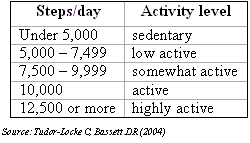A pedometer is a device that counts the number of steps you take.
Walking has been described as the perfect exercise. It is something that nearly all of us can do. The 10,000 steps a day recommendation originated in Japan, but it has gained acceptance in many countries around the world, including the UK and the US. You can use the following recommendations in conjunction with a pedometer to find out how active you are:

Please note that these recommendations are likely to be too low for children, girls should do at least 12,000 a day, whereas boys should do at least 15,000.
For an average-sized person, 10,000 steps is the equivalent of approximately five miles, though obviously depends upon how long your stride is. It's also equivalent to about 300-400 calories.
That's where the pedometer comes in. You may be surprised about how many steps you take in an average day without taking any deliberate walking, on the other hand - you may be shocked about how few steps you take by leading a sedentary lifestyle.
A pedometer is useful in two ways:
In monitoring activity on a day to day basis you can compare your activity level against the 10,000 step recommendation. Simply by making you are aware of how active you are (and how active you should be), this information can help motivate you.
Armed with this information, you can set yourself a hierarchy of goals. If you are leading a sedentary lifestyle (i.e., someone who takes under 5,000 steps/day), then you can set a goal to increase your daily step-count gradually by adding an extra 2,000 steps into your routine. You should also set a longer-term goal to increase your step count to 10,000 steps.
Most pedometer manufacturers sell a range of products to choose from, some are more expensive than others and have more features. When choosing a pedometer, you naturally want to know what is on offer - we have put together a practical guide to help you choose.
Generally speaking, there are three levels of pedometer currently available:
Scientific research has shown that pedometers are generally highly accurate at counting steps, but less good at estimating distance - after all people vary their stride length in everyday life depending upon the speed they are walking at. Calorie estimation is even less accurate, as most pedometers don't take age into account and therefore cannot correctly estimate metabolic rate - for this reason, calorie estimates will be inaccurate for children.
More advanced pedometers are becoming available, some have a built-in diary which records your steps over a number of days, others calculate your total walking time in minutes and seconds, some even have a pulse-rate reader.
In the light of the current scientific evidence for pedometers, we have decided to judge them on the qualities that are likely to make the most difference to your daily lifestyle, namely: accuracy in counting steps, robustness, size, design, user-friendliness, and price. We also thought it was important to inform you of the scientific findings for some of these pedometers.
We tested the accuracy over four different free-living conditions, all of which are likely to occur in daily life:
As an approximate guide, 1, 000 steps is roughly equivalent to 10 minutes of brisk walking. Read this article to learn more about the 10,000 steps challenge.
The best way to attach a pedometer is to clip it to a belt in between your hip and the top of your thigh. If you don't wear a belt, then the top of your trousers/skirt is good enough, as long as it is firmly attached and won't wobble from side to side. Make sure the pedometer stays horizontal; it will not count accurately if attached at an angle. A pedometer will not work correctly if you put it in your pocket.
All the pedometers we tested used small 'watch-type' batteries, they tend to last about a year but they are very cheap and easy to replace.
A good range of pedometers can be found in most specialist sport shops and department stores. Pedometers can also be bought online.
The lever-arm in the pedometer makes a noise as you take steps; your pedometer is therefore probably not broken.